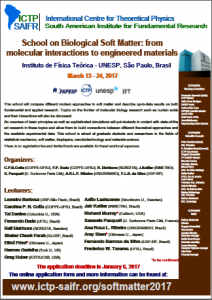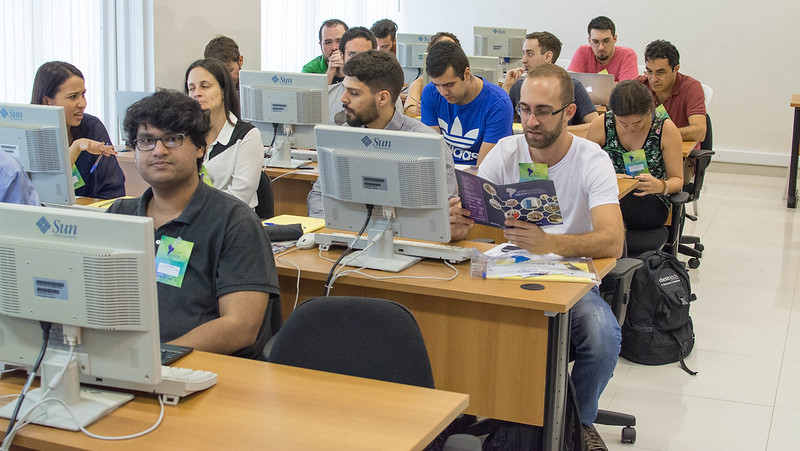School on Biological Soft Matter: from molecular interactions to engineered materials
March 13 – 24, 2017
São Paulo, Brazil
ICTP-SAIFR/IFT-UNESP
![]()
Home
This school will compare different modern approaches to soft matter and describe up-to-date results on both fundamental and applied research. Topics on the frontier of molecular biology research such as nucleic acids and their interactions will also be discussed. An overview of basic principles as well as sophisticated simulations will put students in contact with state-of-the art research in these topics and allow them to build connections between different theoretical approaches and the available experimental data.
In addition to presenting posters, participants will be invited to give short talks on their research activity. This school is aimed at graduate students and researchers in the fields of statistical mechanics, materials science, biophysics and nanobiotechnology. There is no registration fee and limited funds are available for travel and local expenses.
Organizers:
- Carolina Palma Naveira Cotta (COPPE-UFRJ, Brazil)
- Fernando Pereira Duda (COPPE-UFRJ, Brazil)
- Ralf Eichhorn (NORDITA, Sweden)
- Jair Koiller (INMETRO, Brazil)
- Samuela Pasquali (U. Sorbonne Paris Cité, France)
- Ana Rosa Lopes Pereira Ribeiro (UNIGRANRIO, Brazil)
- Fernando Luís Barroso da Silva (USP-Ribeirão Preto, Brazil)
Satisfaction survey:
Lecturers
First week
The study of protein-protein interaction as seem by small-angle X-ray Scattering
Leandro Barbosa (USP-São Paulo, Brazil)
In this lecture I will discuss about the protein-protein interactions as seem by small-angle X-ray Scattering techniques using model proteins, such as Lysozyme and Serum Albumin at different concentrations and ionic strengths. Several alternative theoretical models will be presented to the students.
Synthetic Biology: From Microbial Genetic Circuits to New Therapies
Tal Danino (Columbia U., USA)
Rapid advances in the field of synthetic biology have enabled the design and construction of genetic circuits capable of generating programmed behavior in microbes. Concurrently, the last decade of microbiome research has revealed an astounding prevalence of microbes in diverse tissues previously thought to be sterile, such as solid tumors. These emergent fields have prompted the exploration of microbes as a natural platform for the development of engineered therapies and diagnostics. In this research talk, I will describe our progress towards a new design framework for engineering microbial gene circuits that bridges computational modeling and in vitro characterization, to diagnostic and therapeutic applications for cancer in vivo. This talk will begin with a description of bacterial gene circuits that generate synchronized oscillations, and will then describe development of programmed bacteria as both diagnostic and therapeutic agents for cancer.
Dynamics on the micro-scale: Brownian motion and electrokinetic effects
Ralf Eichhorn (NORDITA, Sweden)
This lecture will provide a basic introduction to particle motion in fluidic systems on the micrometer scale (and below), where thermal fluctuations play a noticeable role. We will introduce the standard model for Brownian motion to describe the diffusive component in the particle’s motion. Amongst the various deterministic driving forces, we will focus on electrohydrodynamic effects such as electrophoresis (particle motion due to an external electric field). If time permits, the latter will be extended to general phoretic transport phenomena.
Proteins and nucleic acids: basic concepts and challenges?
Shaker Chuck Farah (IQ-USP, Brazil)
Basic introduction to proteins and nucleic acids, discussing important challenges in this research fields from an experimental point of view?
Multiscale modeling of DNA
Aatto Laaksonen (Stockholm University, Sweden)
- Statistical Mechanics of soft and biological matter and modern computer modeling and simulation techniques
- Multi-scale computer simulations of structure and dynamics in canonical and non-canonical DNA. Modeling of DNA in chromatin.
- Coarse-grained simulations of structure and dynamics circular DNA. The effects from electrostatic interactions and importance of large cut-offs
The physics of nucleic acids
Samuela Pasquali (U. Sorbonne Paris Cité, France)
a. RNA/DNA systems, presentation of their structural features and role of ions
b. Modeling electrostatic interactions in nucleic acids : examples from selected articles
c. Coarse-grained force fields: proteins and nucleic acids
d. Advanced simulation techniques (REMD, ST, basing hoping MC, interactive simulations, …)
Peculiar electrostatic mechanisms observed in biomolecular systems
Fernando Luís Barroso da Silva (USP-Ribeirão Preto, Brazil)
On the peculiar electrostatic effects observed in protein systems – a computational approach
– Electrostatic interactions in and between molecules
- pKa calculations
– Ion-ion correlation and charge fluctuation mechanisms.
– Molecular modeling and Monte Carlo simulations
– Calcium binding proteins
– Protein-protein, protein-polyelectrolyte, protein-RNA and protein-nanoparticle interactions
The Electrostatic Effects in Colloid (and Protein) Thermodynamics
Frederico W. Tavares (UFRJ, Brazil)
Using Molecular Simulation, Density Functional Theory, and Poisson-Boltzmann equation to calculate ion concentrations close to charged and non-charged surfaces. Thermodynamics properties related to ion specificity, Hofmeister effects, size and electrostatic correlations. Application of these concepts to calculate protein adsorption on charged surfaces as a function of ion concentration, pH, ion type, and temperature.
Second week
Stimuli-responsive hydrogels
Fernando Duda (UFRJ, Brazil)
Stimuli-responsive hydrogels are cross-linked, macromolecular polymer networks embedded with water that may exhibit large, reversible, changes in volume, shape, permeability, mechanical properties, and surface characteristics in response to various environmental stimuli. They find applications in fields as diverse as microfluidics, biosensing, biocomputing, drug delivery, tissue engineering, and bone regeneration. In the particular field of cell culture, it was recently shown that, when subjected to electric fields, electro-responsive hydrogel-based scaffolds are able to impart dynamical loads that enhance longevity, proliferation and regulate differentiation of embedded adult stem cells.
The purpose of this lecture is to discuss and apply the principles of mechanics and thermodynamics to describe the complex behavior of stimuli-responsive hydrogels.
Cell biology and its mathematical tales, from the cell’s movement to its physiology
Hermes Gadelha (York U., UK)
A detailed look at the biological world generates endless untracked problems in fluid and solid mechanics. Cells and microorganisms endure in a variety of environments. Nodal cilia generate flows that are responsible for determining the normal asymmetry of the internal organs of the mammalian body; trypassonamitid infection use whip-like appendages to achieve propulsion. Microtubules assemblies supports the cytoskeleton mechanics and provide railways for fast and precise transport of proteins through mediated by the cell. Cellular membranes deform dynamically at the microscale and actively select the passage of molecules that are essential for sustaining life. We will explore how mathematical modelling and simulation can be used to shed new light in cellular biology, from locomotion of microorganisms and flagellates to cellular mechanics, its physiology and even cancer. This will be achieved by combining constructively concepts from solid and fluid mechanics to formulate simple but powerful elastohydrodynamic models. We will further demonstrate how the latter can be utilized to interpret paradoxical empirical observations. Finally, we highlight that this is a fertile and challenging area of inter-disciplinary research and demonstrate the importance of future observational and theoretical studies on the underlying mathematics of cellular biology.
Reference: BBC news, March 2017
Terasaki Ramps: A Glimpse into the Geometrical Architecture of the Cell
Greg Huber (KITP/UCSB, USA)
Biologists have long considered the endoplasmic reticulum (ER) to be an exceedingly important and complex intracellular organelle in eukaryotes. It is a membrane structure, part folded sheet, part branching network, that both envelopes the nucleus and threads its way outward, all the way to the cell’s periphery. Microscopic images attest to its convoluted geometry, but can the complexity of its architecture be understood in a precise, mathematical way? Recently, refined imaging of the ER has revealed beautiful and subtle geometrical forms – “Terasaki ramps” — suggestive of Riemann sheets and helical minimal surfaces. What is the physics of these structures, can it speak to their formation, and how do the structural motifs connect to biological function?
A gentle introduction to the mathematics of microswimming
Jair Koiller (INMETRO, Brazil)
Locomotion of microorganisms takes place in the Stokesian regime. The time independent incompressible Stokes equations are linear elliptic PDEs that can be studied by a variety of analytic and numerical methods. In our lectures we will describe some of those and we will also explain why optimal microswimming is a “gauge theory of something” (A. Shapere). We will look at some distinguished papers from the literature starting with Sirs G. I. Taylor and J.Lighthill in the 1950’s. Purcell’s “Life at low Reynolds number” will be discussed in detail. We will also look at some of the more recent contributions, specially on collective motion, locomotion on complex fluids, and situations were inertia still plays a role, eg. in acoustic streaming.
A biomimetic approach: from tissue regeneration to nanotoxicological models
Ana Rosa Lopes Ribeiro (UNIGRANRIO, Brazil)
The biomimetic approach represents a new strategy pursued in the field of human regenerative medicine, and the extracellular matrixes of animal tissues is a source of inspiration for biomaterial developments. Nowadays the existing biomaterials lack the inherent adaptability of natural tissues, they do not truly mimic the chemical and structural dynamic environment required fortissue regeneration. I will explore a biomimetic model from the morphological, chemical and biomechanical point of view and the studied concepts will be translated to the field of regenerative medicine. Also I will discuss the use of 3D in vitro models that mimic human physiological conditions, and explore the interactions of engineered nanomaterials with cells giving a glance at the nano – biointerface. The problems and challenges of the nanotoxicological field will be also discussed.
Poster
Program
School Program: PDF version (updated on March 16, 2017)
Files:
Jair Koiller
- A gentle introduction to the mathematics of microswimming
- A gentle introduction to the mathematics of microswimming – Notes and exercises
- Analysis of the Swimming of Microscopic Organisms; Geoffrey Taylor
Ana Ribeiro
Fernando Duda
By request of some lecturers, this material is available online only for participants.
Photos
Additional Information
List of Confirmed Participants: Updated on March 13
Poster presentation: Participants who are presenting a poster MUST BRING THE POSTER PRINTED. The poster size should be at most 1,5m x 1m.
Registration: ALL participants should register. The registration will be on March 13 at the institute from 8:30 to 9:30 am. You can find arrival instructions at http://www.ictp-saifr.org/?page_id=195
Accommodation: Participants, whose accommodation has been provided by the institute will stay at The Universe Flat. Each participant, whose accommodation has been provided by the institute, has received the accommodation details individually by email.
BOARDING PASS: All participants, whose travel has been provided or will be reimbursed by the institute, should bring the boarding pass upon registration, and collect an envelope to send the return boarding pass to the institute.
Emergency number: 9 8233 8671 (from São Paulo city); +55 11 9 8233 8671 (from abroad), 11 9 8233 8671 (from outside São Paulo).
Ground transportation instructions:
Ground transportation from Guarulhos Airport to The Universe Flat
Ground transportation from Congonhas Airport to the Universe Flat
Ground transportation from The Universe Flat to the institute

